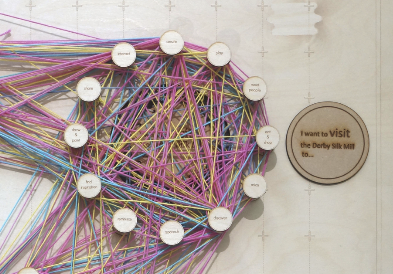
Year | 2015
Location | Derby, UK
Client | Daniel Martin – Curator of Making, Derby Silk Mill
Sheffield School of Architecture’s Live Projects and Derby Silk Mill are investigating innovative ideas for self-build display and storage units. The first stage of the museum’s grant funded redevelopment invited the public as citizen curators to design and build new displays on the ground floor of the Silk Mill. The scope of this Live Project extends to the wider aim of creating Derby Silk Mill – Museum of Making and the entire redevelopment of the world’s first factory.
The Silk Mill has vast collections in all major subject disciplines made up of artefacts which all have various conservation and handling requirements. There are many ready-made solutions that already exist albeit at a cost uneconomical with an estimated collection of over 250,000 objects. The first stage of redevelopment reinforces public participation as a cornerstone of the museum’s future vision and their present ambition.
Currently, the Silk Mill uses an onsite workshop to equip its staff with the tools to respond to the needs of the collection. Outside of ‘office hours’ the workshop welcomes community groups, schools and the general public, teaching skills ranging from joinery to programming. Once a week, a private members club for skilled makers almost serves as a marketplace within a ‘give/get’ economy, where the sharing of skills, time and ultimately effort allow the Silk Mill to host and facilitate the transformation of the museum.
Through drawings and physical prototyping, the research investigates how the public can interact with not only the collection but the display of the collection at different levels. Considering perspectives on making from skilled carpenters to first-time visitors, the design proposal responds to various skill levels, and proposes a base module which can be fabricated in the workshop but assembled by anyone: with precedent found in japanese joinery and puzzle boxes it offers a no-fixing, no-glue environmental solution which becomes part of a community makers’ process. As this develops, upskilled visitors and experienced makers can augment these modules based on the needs of the object and/or curator.
By undertaking the same journey as a would be visitor, this Live Project has recorded curiosities, experiments and processes from the first visit to the final prototype in a workshop diary. Being a maker extends beyond mere assembly. As this project has shown, an understanding of fabrication techniques and knowledge of workshop workflows is essential. This diary serves to start a prospective maker in the right direction. Although by no means exhaustive, the documentation and analysis of making and remaking highlights the importance of iterative design and improvement. Visual visitor guides were also created to explain the unusual structure of the final prototype along with design possibilities based on a selection of archived objects.
A handover of all gathered knowledge to the Silk Mill is only the beginning of a new creative process in which the outcomes are unknown. Fittingly, it is intrigue and curiosity that play the most important roles in the longevity of the workshop as a gateway to Derby’s rich industrial heritage.
www.archiveandthemachine.wordpress.com

